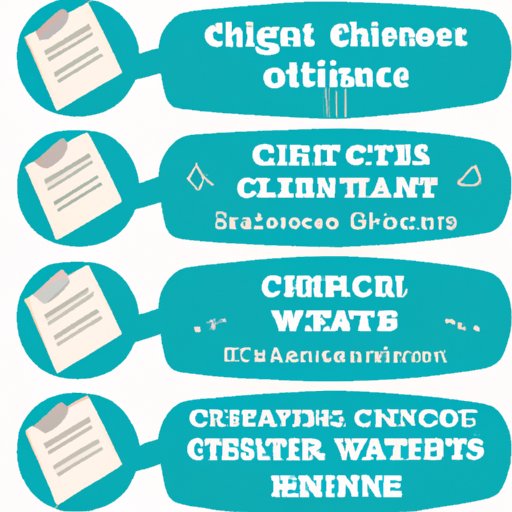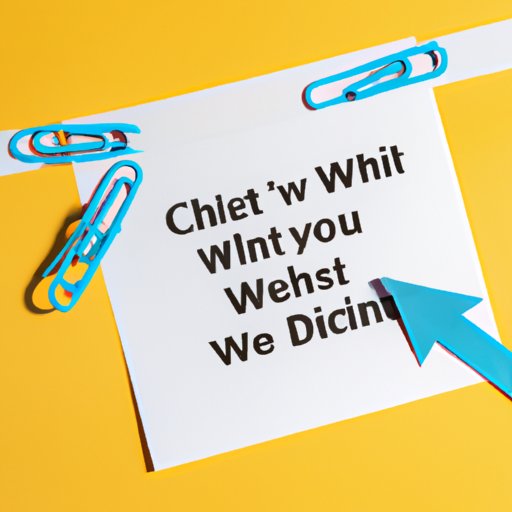
How to Cite Websites: A Comprehensive Guide
As the internet continues to provide a vast array of information at our fingertips, researchers and writers are increasingly turning to websites as credible sources of information. However, citing websites can be tricky, with varying styles and formats depending on the citation style being used. Properly citing website sources is crucial in avoiding plagiarism and giving credit to the original author. In this article, we will explore everything you need to know about properly citing websites, including the different citation styles, tips and tricks for citing difficult sources, online tools to aid in citation, and common mistakes to avoid.
7 Easy Steps to Properly Cite Websites in Your Research Papers
Here are seven easy steps to follow when citing websites in your research papers:
Step 1: Start with the author’s last name and first name, followed by a period. If no author is listed, simply start with the title of the web page.
Step 2: Next, include the title of the website in italics, followed by a comma.
Step 3: Identify the publisher or sponsor of the website, followed by a comma.
Step 4: Include the date of the publication or last update of the website, followed by a comma.
Step 5: Add the URL or permalink of the website, ensuring that it is a complete link.
Step 6: Add the date that you accessed the website, following the format of “Accessed [date]” or “Retrieved from [URL] on [date].”
Step 7: Finally, make sure to format the citation according to the citation style being used, such as MLA, APA, or Chicago.
Below are examples of how to properly cite websites in various citation styles:
APA Style: Last, F. M. (Year, Month Date Published). Article title. Retrieved from URL.
MLA Style: Last, First Name. “Title of Web Page.” Title of Website, Publisher or Sponsor, Date of Publication or Update, URL. Date Accessed.
Chicago Style: Last, First Name. “Title of Web Page.” Title of Website, Publisher or Sponsor, Date of Publication or Update, URL or permalink. Accessed Date.
The Ultimate Guide to Citing Websites: Tips and Tricks You Need to Know
With so many sources available online, it can be difficult to distinguish credible sources from unreliable ones. Here are a few tips for finding reliable sources online:
1. Start with reputable websites: Websites such as government websites, academic institutions, and established news outlets are generally reliable sources of information.
2. Check the URL domain: Websites ending in “.edu” and “.gov” are typically more reliable than “.com” websites.
3. Look for author credentials: When possible, try to find information about the author’s education and experience to determine their credibility.
4. Verify information: Cross-check information with other sources to verify its accuracy.
5. Check the date: Make sure the information is up-to-date and relevant for your purposes.
Additionally, citing websites with no author or date can be challenging. Here are some tricks to help:
1. No Author: Start with the title of the page, and use “Anonymous” in place of the author’s name.
2. No Date: If the website has no date of publication, use “n.d.” instead.
3. No Author or Date: If there is no author or date listed, start with the title of the web page and include the URL, followed by the date accessed.

Why Citing Websites is Crucial and How to Do It Right
Failing to properly cite websites can have serious consequences, including being accused of plagiarism. To avoid these issues, it is important to know the proper ways to cite websites. Here are some things to keep in mind when citing websites correctly:
1. Giving credit to the original author: Citing websites allows you to give credit where it is due and avoid taking credit for someone else’s work.
2. Avoiding plagiarism: Properly citing websites helps you avoid the ethical and legal issues associated with plagiarism.
3. Building credibility: Citing credible sources can help you build credibility with your audience and establish a strong argument.
To properly cite websites, make sure to follow the guidelines for your chosen citation style and include all necessary information, including the author’s name, title of the web page, publication date, and URL or permalink.
How to Avoid Plagiarism by Citing Websites Effectively
Plagiarism is a serious offense in academic and professional settings, and properly citing websites is a crucial part of avoiding it. Here are some tips on how to avoid plagiarism when citing websites:
1. Use quotation marks: When using direct quotes from a website, use quotation marks to indicate that the words are not your own.
2. Paraphrasing: If you are summarizing or paraphrasing information from a website, make sure to include a citation indicating the source of the information.
3. Citing all sources: Make sure to cite all sources used in your research, including websites.
4. Using plagiarism checkers: Utilize online plagiarism checkers to ensure that your work is original and properly cited.
Citation Styles for Websites: MLA, APA, Chicago, and More
There are various citation styles for citing websites, including MLA, APA, Chicago, and more. Here are some examples of how to properly cite websites in these styles:
APA Style: Last, F. M. (Year, Month Date Published). Article title. Retrieved from URL.
MLA Style: Last, First Name. “Title of Web Page.” Title of Website, Publisher or Sponsor, Date of Publication or Update, URL. Date Accessed.
Chicago Style: Last, First Name. “Title of Web Page.” Title of Website, Publisher or Sponsor, Date of Publication or Update, URL or permalink. Accessed Date.
Make sure to check the guidelines for your chosen citation style to ensure that you are properly formatting your citations.
Online Tools to Help You Cite Websites Quickly and Accurately
Luckily, there are many free online tools available to aid in citation generation. Here is a list of some of the most popular ones:
1. EasyBib: This tool allows you to generate citations for various sources, including websites, in various citation styles.
2. BibMe: Similar to EasyBib, BibMe generates citations for websites and other sources in multiple citation styles.
3. Zotero: This tool not only generates citations but also allows you to save sources and organize your research.
4. Citation Machine: Citation Machine generates citations for various sources, including websites, in multiple citation styles.
While these tools can be helpful in generating citations quickly and accurately, it is still important to double-check the citations to ensure that they are properly formatted and include all necessary information.
Common Mistakes to Avoid When Citing Websites and How to Fix Them
There are some common errors that people make when citing websites. Here are some tips on how to identify and fix these errors:
1. Missing information: Make sure to include all necessary information, such as the author’s name, title of the web page, publication date, and URL or permalink.
2. Incorrect formatting: Double-check the guidelines for your chosen citation style to ensure that your citations are formatted correctly.
3. Using outdated information: Make sure that the information you are citing is up-to-date and relevant.
Conclusion
Properly citing websites is an important part of research and writing. It helps you avoid plagiarism, give credit to the original author, and build your credibility with your audience. By following the guidelines for your chosen citation style and utilizing online tools when necessary, you can ensure that your citations are accurate and properly formatted.
Remember to double-check your citations for missing information and formatting errors, and to always use reliable sources when conducting research.





